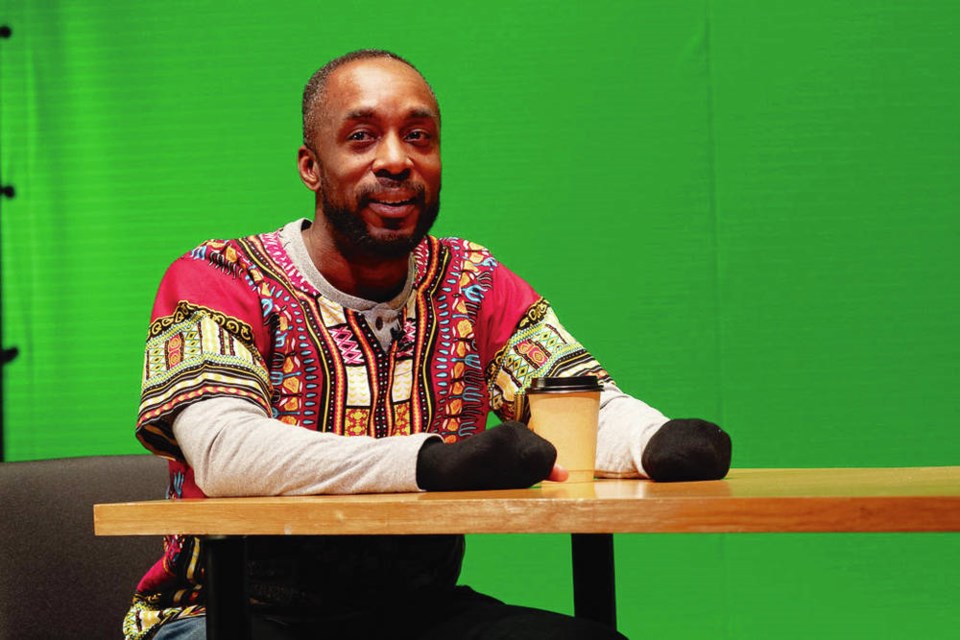A modest proposal — perhaps the Belfry Theatre’s Being Here: The Refugee Project should be required viewing for Canadians bitterly lamenting COVID-19 restrictions.
Devastated about that canceled trip to Los Cabos? Consider the plight of Ghanaians who trudged to Canada in deadly winter and lost fingers to frostbite. Upset your cocktail parties are on hold? Cast your thoughts to Alan Kurdi, the Syrian toddler who drowned during his refugee family’s desperate exodus (you may recall the terrible photographs).
These unhappy tales — and others that are variously curious, heart-warming, disturbing and life-affirming — surface in Being Here: The Refugee Project. Created by Joel Bernbaum and directed by Michael Shamata, this verbatim play, having its online world premiere this week, documents the experiences of refugees in Canada and those who help them.
Remarkably, all dialogue is lifted directly from interviews. Not a single word was changed. With Shamata’s careful directorial assistance, Bernbaum (who interviewed 200 people from such locales as Victoria, Winnipeg, Calgary and Saskatoon) includes every hem and haw — even chuckles and coughs are meticulously retained.
This earnestly literal approach, while admirable, can be constrictive. The film eschews showy visuals — performers are typically presented against blank backgrounds, sometimes talking-head style.
Perhaps a less rigorous emphasis on journalistic verisimilitude — and more on theatrical interpretation — might had made for a more entertaining piece. The show is less engaging than Bernbaum’s verbatim work Home is a Beautiful Word, an excellent 2014 examination on homelessness in Victoria. (To be fair, it’s partly because that production was live theatre rather than online.)
That said, the seven-person cast of Being Here: The Refugee Project did a remarkable job with the daunting task of making the transcripts sing. Several sequences spring to life in a powerful manner — we forget we’re watching actors and become one with the characters and their stories.
One strength of Being Here: The Refugee Project is its determination to avoid easy answers. Take the tragic end of Alan Kurdi, which was reported internationally. In strictly dramatic terms, this story (and the tale of the death-defying Ghanaians) are among its most powerful. In this show we learn of a fascinating irony. The viral power of the Kurdi photograph led to Syrians becoming the preferred “brand” for refugee sponsors refugees. This, says one character, came at the expense of refugees from other countries.
Why is this image so potent? Simply put, many North Americans empathized with the Kurdi because he looked like our kids: fair skin, nice red T-shirt and blue shorts. ”The way the child looked … [he] looked like everybody’s child,” says one character in the show. Another character, identified as a “Middle-Eastern Canadian,” wonders if a black child in rags would have the same impact.
Here and elsewhere, Bernbaum delves into hard truths behind the headlines. This, perhaps, is the most compelling aspect of Being Here: The Refugee Project. Paradoxes emerging from the refugee situation are revealed in a complex yet stark manner that sidesteps easy answers and sentimental tropes.
One sponsor from Lunenburg (portrayed deftly by Celine Stubel) is devastated when her Syrian refugee family disappoints. She’s aghast when they buy expensive cars they cannot afford and then demand financial help. They find fault with their lodgings and then complain about the toilet in their new apartment. Then the father, Ali, faces criminal charges for committing an unforgiveable act.
“It’s been a mess,” says Stubel’s character. “We felt so sick. It was just this feeling of horror.”
There is, too, the moment of jarring self-awareness when the well-meaning Lunenburger recognizes something patronizing within her own attitude. She’d assumed the refugee family would reward her generosity by loving her back — a “bad expectation.” Still, she concludes, one bad apple doesn’t spoil the whole barrel, noting: “Everyone deserves lots of chances.”
The notion of the Hallmark ending is similarly upturned by a Palestinian refugee (Kayvon Khoshkam) who struggles against daunting odds to immigrate to Canada. Ultimately he achieves their dream only to find he longs to return to his homeland. A brother-in-law, already living in Canada, convinced him to lie in order to gain asylum, concocting a story about being a secret spy for Israel. Khoshkam’s character went along with the ruse only to realize he could not live a lie: “I did something horrible… I felt I was completely destroyed.”
Being Here: The Refugee Project concludes with the story of Seidu Mohammed and Razak Iyal (they have pseudonyms in the film), two refugees from Ghana who nearly perished in 2016. On a cold December night they waded for miles through waist-deep snow across the border from Minnesota to Manitoba.
Played with wonderful humanity and warmth by Austin Eckert and Adrian Neblett, the men narrowly avoided freezing to death. However, their frost-bitten digits — which turned hard and black — had to be amputated.
“We lost our fingers but we’re still part of society,” says one hopefully. “We can still do a lot of things.”
***
Being Here: The Refugee Project, commissioned by the Belfry Theatre, is the first show the company has produced since the onset of COVID-19. It’s now being streamed (tickets are $25) on the Belfry Theatre’s site, with final performances Saturday and Sunday (March 20 and 21).



